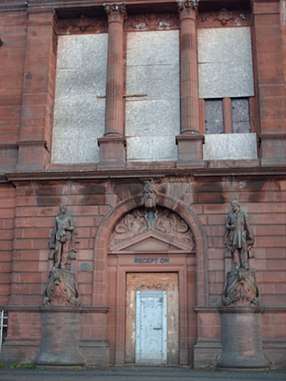Fairfield Offices
The Fairfield Heritage Centre is situated on Govan Road, Glasgow, Scotland. Built as the offices of Fairfield Shipbuilding and Engineering Co Ltd between 1889-1891 the building was used as the principal offices for successive owners of the adjacent shipyard until 2001, when it was vacated by BAE Systems Marine. After deteriorating unused for 8 years it was bought by social enterprise charity Govan Workspace in 2009. Following a restoration costing over £5.8m it was re-occupied as a heritage centre and commercial offices in 2013.
| Fairfield Heritage Centre | |
|---|---|
 Fairfield Offices Main Entrance, prior to restoration. |
| Shipyard built | 1864-1871 |
| Offices built | 1888-1891 |
| Located | Govan Road, Glasgow, Scotland |
| Original Use | Offices for owners (various) of the adjacent Fairfield Shipyard from 1891 – 2001. |
| Current Use | Heritage Centre with free admission. Office accommodation for commercial use. |
| Current Owner | Govan Workspace Ltd |
| Website | https://web.archive.org/web/20120215133418/http://www.fairfieldgovan.org.uk/ |
| Fairfield on Map | |
|---|---|
 Location of Fairfield on Map in Glasgow council area | |
| Location | Govan, Glasgow, Scotland |
| Coordinates | 55°51′51.04″N 4°19′13.34″W |
| OS grid reference | NS5488565879 |
Heritage Centre and Offices
The Fairfield Heritage Centre includes the former boardroom, management offices and directors dining room as well as the main entrance and lobby. 18,000 sq. m of modern office suites are located in the former drawing offices on the first floor and the former counting house on the ground floor.
The heritage area, which is free to visit, tells the story of over 150 years of shipbuilding at the yard using artefacts, graphic panels, interactive media and audio-visual presentations. Exhibits and information address technical innovation, the period of building ships to contest the Blue Riband for fastest Atlantic crossing, the two world wars, the 1960s Fairfield Experiment in management/labour relations and the Upper Clyde Shipbuilders era. In 2006, BAE launched the 750th vessel to be built at Fairfield.[1] The yard was built on the former Fairfield farm between 1864 - 1871.
It is situated on Govan Road, Glasgow, opposite Elder Park, 200 metres west of the Pearce Institute and 300 metres west of Govan subway and bus interchange.
History
At the time it was built the yard was one of the leading shipbuilding yards on the River Clyde[2][3] and this was reflected in a prominent exhibition stand in the Main Hall at the first Glasgow Exhibition in 1888.[4] Amongst the early special events held in the offices were the launch parties for the Cunard liners Campania and Lucania in 1892 and 1893.[5]
It was designed by Honeyman and Keppie, an architectural practice which was then at 140 Bath Street, Glasgow[6] and which survives as Keppie Design[7][8] and is now headquartered in 160 West Regent Street, Glasgow in the former John Ross Memorial Church.[9] John Keppie is thought to have been the lead designer of the building.[10][11] Charles Rennie Mackintosh was a junior member of staff at the firm from 1888[12] and is thought to have worked on the project.[13]
It was built for the Fairfield Shipbuilding and Engineering Co. Ltd. The driving force behind the business at that time and probably the initial advocate for commissioning the new offices was Sir William Pearce[14] whose painting hangs in the boardroom and who was sole owner of the business from 1878 and local member of parliament from 1886 but who died before it was completed.[15]
The name of the company was changed from Randolph Elder and Co. to Fairfield Shipbuilding and Engineering Co. Ltd. in 1885 by Pearce.[16] Named after the former farm he re-structured in order to be able to bid for naval tenders.
Sir William Pearce was a philanthropist who paid for the nearby Pearce Institute. Isabella Elder, the former owner of the yard and widow of former owner John Elder was also philanthropic and commissioned the nearby Elder Park which was originally laid out to a scheme by John Honeyman.[17]
The building was planned to be both functional and to impress visiting clients and potential clients. It includes many Italianate and Beaux Arts elements. There are also Art Deco features which would have been added later. As a functioning hub of the business it included large, light spaces for the draughtsmen working on both shipbuilding and engineering drawings. The building is protected by a Category A listing.[18] John Keppie studied in Paris with the academic atelier architect Jean Louis-Pascal during the 1880s.[19] Although it was probably Honeyman who secured the commission as he had benefitted previously from the patronage of John and Isabella Elder the project was led by Keppie. Its external features include figures of a shipwright and an engineer sculpted above the main entrance. These were by Glasgow-based sculptor James Pittendreigh Macgillivray who also collaborated with Keppie on other work.[20]
References
- BAE Systems Press Release 10/1/2006
- British Shipbuilding Yards. Vol 2. Norman L Middlemiss. Shield Publications 1994. P11 ISBN 1-871128-11-0
- John R Hume Clyde Shipbuilding B.T Batsford. P134. ISBN 0-7134-2913-5.
- Victorian City. Frank Wordsall. Richard Drew Publishing. 1988. P10
- Studies in Scottish business history. Peter Payne. 1967. P57 Routledge. ISBN 978-0-714-61349-9
- Kinchin and Kinchin Glasgows Great Exhibitions 1998 P32
- http://www.cunard.co.uk/About-Cunard-Line/Cunard-Heritage retrieved 7/2/2011
- British Shipbuilding Yards. Vol 2 Middlemiss P.13
- Charles Rennie Mackintosh by James Macauley and Mark Fiennes. 2010. W W Norton. P.82 ISBN 978-0-393-05175-9
- http://www.scottisharchitects.co.uk
- David Stark Charles Rennie Mackintosh and Co. 1854-2004.Stenlake Publishing. 2004. P143. ISBN 1-84033-323-5
- Stark. P.294
- RIBA Council Records.
- Charles Rennie Mackintosh by James Macauley and Mark Fiennes.
- W.W.Norton P.82
- Rebecca Bailey Scottish Architects Papers. Rutland Press. 1996. pp 147 and 257
- Payne. 1967. P57
- Payne. 1967. P58
- Oxford Dictionary of National Biography.
- David Stark Charles Rennie Mackintosh and Co 1854- 2004.Stenlake Publishing 2004. P114